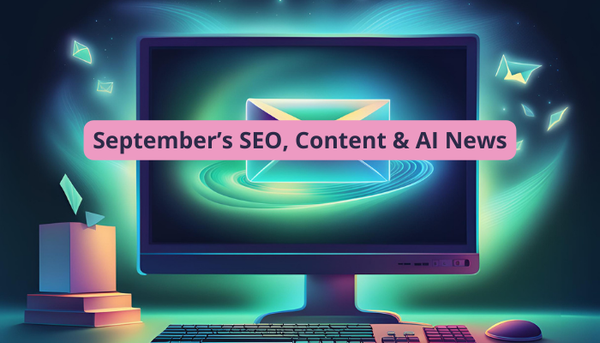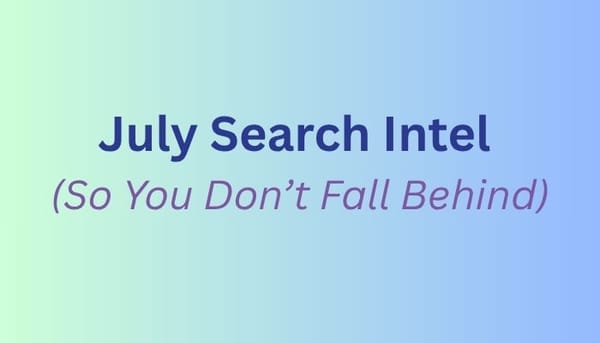July Search Recap & August Action Items

If you were hoping for a quiet month in search, that’s adorable. Google rolled out another batch of updates—some of them obvious, some that will show up in your analytics before you see the announcement. There’s a new AI button, more experiments with how results are grouped, and yes, another round of core changes. If your traffic moves, you’re not imagining it.
This issue covers what’s changing, why it matters, and which “new features” you can safely ignore while everyone else panics in Slack.

Google’s “AI Mode” Button Now Front and Center
With the new AI Mode button front and center on Google, search is about to look different for a lot more people. If you’ve followed the impact of AI Overviews, you already know what’s coming: zero-click searches keep climbing, and publishers are seeing organic traffic drop anywhere from 30% to 70% depending on their niche and how often Google cites their site.
It’s worth noting—most of the hard traffic data so far is about AI Overviews, not AI Mode itself. But the mechanics are similar: when Google surfaces answers directly, fewer people click through. If AI Mode becomes the default view, expect those click-through rates to shrink even further, especially for sites that rely on informational queries.
That said, the game isn’t over. There’s still plenty of opportunity for brands and publishers who adapt quickly. Pages that are cited, trusted, or offer the deepest answer on a topic have a genuine edge. High-authority domains are being cited more often, but there’s also more space opening up for content that is unusually thorough, well-organized, or answers questions competitors haven’t touched yet. Niche and original content can still break through, especially if you’re willing to go further or smarter than what’s already out there.
Review your top content and see how it appears in AI Mode—look for ways to expand, clarify, or add value that others miss.
Refresh your internal linking and hub pages—these are getting more visibility and citations.
Don’t just chase rankings; focus on being the source Google wants to cite, whether that means deeper expertise, clearer organization, or unique research.
Watch for new keyword patterns in your analytics and adjust quickly.
Bottom line: AI Mode is still rolling out, but there’s a clear advantage for anyone willing to build authority, fill gaps, and become the best answer—not just another answer. If you move now, you’re ahead of the curve.
Google Web Guide: Experimental Changes to Search Results
Google has unleashed another experiment on the search world: Web Guide. This one uses AI to shuffle your search results into topic buckets, so instead of scrolling a single ranked list, you get neatly organized clusters. It’s like alphabetizing your bookshelf, if your bookshelf could decide which books are “important” and then hide the rest under the sofa.
Here’s what’s changing: only the top results in each cluster are getting any real attention, and if your page already packs some authority, you might see it pop up in more than one place. For everyone still churning out surface-level blog posts, consider this your warning—thin content isn’t making the cut. On the upside, niche topics and deep dives now have more entry points than before. That oddball article you wrote three years ago might actually show up for once.
It’s worth pointing out: Web Guide is still firmly in the “experimental” camp. You probably don’t have access unless you’ve opted into Search Labs, and even then, only in certain regions. The overachievers in the SEO community are already testing with VPNs and reporting back on what shows up where. If you’re feeling adventurous (or just want a new excuse to avoid real work), you can try it yourself at labs.google.com/search—but don’t be surprised if you get the “not available here” message.
Bulk up your most important pages. Answer more questions, cover more angles, and generally give Google fewer reasons to ignore you.
Dust off those hub pages and topic clusters—they’re more likely to show up in multiple places. (I said what I said)
Start tracking which keywords and queries are bringing in traffic, not just where you rank. The patterns might get weird (in a good way).
VPNs are your friend if you want to see what’s really happening in other countries.
Bottom line: Web Guide is rewarding deep, comprehensive content and giving the edge to anyone willing to actually cover a topic in full. It’s still just a test, but it’s one worth dissecting—especially if you’re tired of watching your best work collect dust in the middle of page three.
Cloudflare Pushes for a Way to Block Google AI Overviews
Cloudflare just made a big claim: CEO Matthew Prince says they’re pressuring Google to finally offer a way to block AI Overviews and Answer Boxes from scraping your content—without kicking your site out of classic search indexing. Right now, you can use “nosnippet” tags, but that nerfs your regular rankings and visibility. There’s no clean, officially sanctioned opt-out just for AI content.
Prince says they’ve already default-blocked Gemini, and that a Google solution for AI Overviews is coming. No details, no dates—just a confident promise that Google will have to cave eventually.
SEOs have been demanding this kind of control for months. Google’s response has basically been “use nosnippet and take your chances.” If Cloudflare gets their way, it could finally let you keep your site in regular search while locking out Google’s AI summarization and answer boxes.
Watch for any official updates from Cloudflare and Google. If an opt-out appears, the technical details will matter
If a real AI Overview opt-out launches, start by testing it on non-critical pages
Keep your regular search optimization clean—don’t rely on “nosnippet” unless you’re comfortable losing rich results and snippets.
Track both classic and AI-driven query performance for any changes.
Be ready to brief clients or stakeholders. This will become a common question as opt-out options evolve.
Bottom line: This isn’t real yet—but if Cloudflare pulls it off, it could be the first time publishers get meaningful control over how Google uses their content for AI features. Stay tuned.
June 2025 Core Update: HCU(X) Comebacks, AI Overview Drops, YMYL Shakes
Google’s June 2025 core update landed hard, driving huge swings in search visibility. Glen Gabe did an excellent analysis on the impact here. Some sites hit by the infamous September 2023 Helpful Content Update (HCU[X]) finally saw real recoveries—yes, actual surges back from the dead. Others, especially in Your Money or Your Life categories like health and finance, got tossed around with the kind of volatility that makes for lively traffic reports and existential dashboards.
The update rolled out fast (just 16 days), but the action started before the official launch. There was already heavy volatility in early-to-mid June, likely from behind-the-scenes reviews system tweaks (not officially “core update” stuff, but the same result for rankings).
AI Overviews and AI Mode were also affected: if your site tanked with this update, you probably lost visibility in those AI features too. This is a reminder—broad core updates hit all Google surfaces, not just blue links.
Not every HCU(X)-impacted site bounced back, though. Some kept sinking—especially those that abandoned quality fixes after too many updates with no results. The lesson: Google only rewards sites that go all-in on quality, across everything—content, user experience, site presentation, technical health, and even ad/affiliate setup.
And for anyone tracking impressions vs. clicks: the “great decoupling” is real, but not universal. Some sites still see coupled metrics (clicks rising with impressions), especially when AI Overviews don’t trigger for their niche.
Don’t ignore Google Search. Quality across the board is still what counts.
If you got hit, run a full audit—content, UX, indexing, technical health, ads/affiliate setup, the lot.
For YMYL sites, triple-check your accuracy, trust signals, and overall E-E-A-T.
If you saw recovery, don’t coast. Keep pushing quality and stay out of Google’s “gray area.”
Expect more core updates soon; lasting recovery takes ongoing, site-wide effort—not band-aids.
Bottom line: The June core update was a reset button. If you’re waiting for a magic trick, there isn’t one. Quality wins, shortcuts lose, and Google will keep changing the game. Stay ready.
AI Summaries Officially Land in Google Discover
AI Summaries Officially Land in Google Discover
Google Discover just launched AI-generated summaries on articles for U.S. users. Each article gets a short, machine-written summary right above the headline, along with a friendly reminder that “AI can make mistakes.” The new “More” window on Trending cards is also less in-your-face than before—just a small pop-up instead of a full-page takeover.
As usual, publishers are not lining up to celebrate. When Google summarizes your article, most users will just read the blurb and move on. If you want clicks, you’ll need to stand out past the summary and give people a real reason to go further.
Make sure your headline and first sentence are compelling—if your point isn’t clear immediately, it’s getting lost.
Use unique data, bold claims, or original insights early in the piece. If Google’s summary misses the nuance, a strong hook might still earn the click.
Structure content with clear subheadings and visuals—these are more likely to get surfaced in summaries and pop-ups.
Track Discover referral trends. If your traffic drops, adjust your content format and lead-ins fast.
Test different content types (e.g., original reporting, explainers, interviews). See what still draws clicks past the AI summary.
Bottom line: Google is officially writing the first impression for your articles in Discover. If you want the click, you’ll need to work for it—starting with your headline, your hook, and the one thing nobody else is saying.
Tailride: 22,000 AI Pages Later, Welcome to Zero Traffic
Tailride just published a refreshingly honest post-mortem on blowing up their own traffic. The playbook: roll out 22,000 AI-generated pages—most of it barely useful, much of it unrelated to the actual product. It worked for a while: rankings for random “return policy” pages, some clicks, a couple of signups. And then, overnight, Google pulled the plug. No notice, no manual penalty, just zeroed out. The index shrank from 20,000 pages to one.
While this was happening, they also caught a cease-and-desist for their brand name. The fix was about as fun as you’d expect: wipe the junk, change the name, and rebuild everything from scratch.
Now, it’s a different play: relevant keywords only, real people writing, one page at a time. Traffic is coming back, but this time it’s slow, focused, and actually tied to the business.
Key lesson: It wasn’t the AI. It was the spammy scale and lack of anything valuable. If you’re chasing numbers for the sake of it, you’ll eventually get the same result—Google will clear you out and won’t send a memo.
Don’t bother publishing pages you wouldn’t want a real user to see.
Only target keywords that make sense for your product or audience.
Thin, off-topic, and copycat content gets you nowhere—especially at scale.
If you’re using AI, treat it as a tool, not a shortcut. Review, edit, and add value.
Build slow. Relevance and trust will outlast any quick win from spammy scale.
Watch your index and traffic. When things tank, fix fast—don’t wait for a miracle recovery.
What Worked in the June 2025 Core Update?
Marie Haynes dug into dozens of sites that came out ahead after the June core update. No surprises: the gains didn’t happen by accident. Sites that won generally did a few things right.
The pages that improved weren’t just long—they actually answered the main question up front, then backed it up with detail, structure, and context. Obvious E-E-A-T signals (first-person stories, original data, real author credentials, external citations) were much more visible. Useful visuals and practical tips helped, too.
Thin content and pure-AI rewrites didn’t just stagnate; they slipped. Even if it wasn’t pure spam, Google seemed to demote anything that didn’t add something new or clearly demonstrate expertise.
Internal linking mattered—pages that connected clearly to other useful content had an edge. Updating stale posts (not just the date, but real, substantive changes) was another pattern among winners.
Get to the point fast: answer the user’s question in the first paragraph.
Show real expertise: add original insight, stories, or data wherever possible.
Include trust signals: cite sources, use clear author bios, and show credentials.
Upgrade thin content—don’t just pad it, add something unique.
Strengthen internal links so users (and Google) can find your best work.
Refresh old pages with actual new info—not just a quick edit.If you’re using AI, treat it as a first draft.
Manual editing and human context are non-negotiable.
When Google’s AI Sells, Not Cites
HouseFresh pulled apart Google’s AI overviews and found what most SEOs suspected: commercial, affiliate-driven content dominates, while independent and critical reviews get sidelined. If you’re not already on the “best of” lists, don’t expect AI to throw you a bone.
Audit the sites and affiliate pages that keep showing up in AI overviews for your keywords—these are your new organic competitors.
Forget waiting for AI to cite you just for “quality.” If the same commercial sites always win, you need another play.
Partner with your paid search team. Buy placement or sponsored content on the review and affiliate sites that Google’s AI favors—if you can’t beat them, join their list.
Track how your niche’s “best” and “top pick” pages change as AI evolves, and adjust your outreach/content accordingly.
Continue building authority and real research on your own site—but have zero illusions about AI “leveling the playing field.” It doesn’t.
If you see a third-party site getting all the AI citations, consider syndicating your content or arranging contributor deals. Brand visibility now travels further than your own site.
Meanwhile, Google swears that to get listed in Google: AI Overviews you should use regular SEO (Nothing Special Needed)
Google’s John Mueller and Danny Sullivan have clarified that AI Overviews rely on the same signals as standard search. There’s no hidden markup, no special code, and no new hoops to jump through. If you’re already focused on technical SEO, content quality, and E-E-A-T, you’re doing what Google wants.
Pages that show up in AI Overviews are the same ones Google already considers high-quality and relevant. If you’re not getting cited, it’s usually a matter of outperforming the competition on those fundamentals.
Stick with proven SEO best practices: solid technical setup, quick site speed, structured data, and clean indexing.
Make E-E-A-T visible: show real authors, cite sources, and add original insights.
Keep your important pages updated with fresh info and richer content.
Use internal linking to highlight your strongest assets.
Skip any tools or hacks promising “AI optimization”—it’s still about the basics.
For Paid Members
Introducing: Content Brainstorming Bot
Tired of getting vague advice about “adding value” to your content? Me too. That’s why I built Content Brainstorming Bot—a tool for people who want practical, non-generic answers on why your content isn’t working and how to fix it with actionable advice and tactics that will help you rank and provide users with helpful content they engage with and share.
Also get my advanced workflow for automated citation analysis to identify areas you can improve to increase your chances of being cited in AI Overviews, and my AI prompt of the month designed to help create more rankable content.




